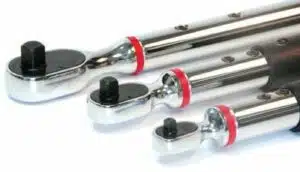
Whether you’re using a torque wrench in a professional setting or in a home garage, you need to know that your fastener is tightened to a specific torque value – otherwise, why would you be using a torque wrench in the first place? You may have purchased an expensive name brand in hopes that you would have an accurate tool for years to come, however; that’s not always the case. What many people fail to realize is that even though the quality of a torque wrench is important, the only way to be confident that your torque wrench is producing accurate results is to have it calibrated on a regular basis. Below are 5 key factors that illustrate the importance of torque wrench calibration.
1) Accuracy Requirements
The accuracy you can expect from a torque wrench is specified by the manufacturer, but the only way you can be sure your specific tool is consistently providing repeatable and accurate results is to periodically validate its performance. Torque wrench accuracy specifications can range anywhere from 6% to 1% and the purchase price usually scales along with it. When required to maintain a very tight torque specification, it is recommended that you purchase a higher-quality torque wrench. Premium brand torque wrenches are more likely to maintain their accuracy specification for longer periods. However, it is still necessary to calibrate the tool frequently enough to establish a good history of performance. When using less accurate economy models that are made from lower quality parts, more frequent calibration may be needed to ensure the tool is providing consistent torque values that you can trust. To comply with industry standards, your torque wrench calibration should be carried out using practices outlined by an internationally recognized standard such as ASTM E2624 which is published by ASTM International.
2) Frequency of Use
As per the official website of the International Organization of Standardization, ISO 6789 states that a torque wrench should be re-calibrated every 5000 uses or every 12 months. However, this is only a minimal recommendation and should never take precedence over process accuracy requirements. Process accuracy requirements are paramount and usually dictate a more frequent re-calibration interval. Re-calibrating your torque wrench in the range of 2500 to 3000 uses is more commonly suggested by most professionals in the industry. Following this logic, the more frequently your torque wrench is being used, the more frequently it needs to be re-calibrated.
3) Improper Storage
Did you know that an adjustable torque wrench should always be “backed off” or stored at its lowest marked setting? A torque wrench is made up of several key components that ensure proper function and accuracy. One of the most critical of these components is the tension spring which is responsible for controlling the applied torque. By design, when an adjustable torque wrench is set at higher torque values, an increased load is applied to the tension spring. If you store your torque wrench at any torque value greater than its lowest setting (usually 20% of maximum), the tension spring will remain under load and weaken over time. This will cause your torque wrench to produce less torque across the range and ultimately lose accuracy. Conversely, if the torque wrench is dialed all the way back to zero, other components in the tool can move slightly, also negatively affecting accuracy. If your torque wrench has been improperly stored for long periods, it will need to be professionally re-calibrated to ensure torque values are accurate. Unfortunately, in some cases, your torque wrench may not be able to be adjusted back within manufacturer’s specifications and will need to be replaced.
4) Temperature & Weather
If you frequently use or your torque wrench in below freezing or extremely high temperatures (above 120 degrees Fahrenheit) you run the risk of your tool developing condensation that can cause internal rusting. Premature rusting can also be caused by operating or leaving your torque wrench out in the elements (rain, sleet, or snow). When the internal mechanisms of the torque wrench develop rust, the accuracy and performance of the tool will suffer. Torque wrenches operated at high temperatures may also experience grease seepage due to the internal lubricants heating up and melting which will also affect the performance and accuracy of the tool.
5) Improper Use
Torque wrenches are designed to be used by applying the appropriate amount of force to the grip of the wrench. Using your torque wrench in any other way may overload the instrument which will compromise accuracy or possibly damage it permanently. ISO-6789 mandates that any torque wrench that has been overloaded by more than 25% must be re-calibrated. Do not use pipes or cheater bars and never use the wrench as a breaker bar. Accidental drops are especially important to avoid. Dropping a torque wrench just once may affect the accuracy by as much as 30 percent!
Determining the frequency of calibration for your torque wrench may be mandated by your specific industry or it could be a personal decision based on one or many of the factors above. Regardless, finding a trusted torque wrench calibration service provider is vital to verifying your instrument’s readings and making any necessary adjustments to bring your torque wrench back into manufacturer’s specifications. Precision Calibration Systems is ISO 17025 accredited for torque wrench calibration up to 1100 foot pounds. With our standard 24-48 hour turnaround time, your torque wrench can be quickly and accurately calibrated regardless of your location. For more information, contact us today at (866) 521-3823.

